Burle Marx and the Birth of Modern Landscape Architecture
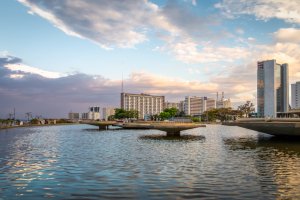
Roberto Burle Marx is basically the godfather of modern landscape architecture. He had an absolutely revolutionary way of designing gardens, parks, and other open outdoor spaces.
Experts see this Brazilian designer as one of the most important figures in 20th-century landscape architecture. In the minds of many architects and landscapers, Burle Marx was the creator of the modern garden.
He wasn’t just an architect, either. He was also a brilliant sculptor and worked in other media like painting, wood printing, mosaics, and countless other things. Burle Marx’s childhood was a definitive factor in his professional career as an adult.
It certainly helped to be around and meet masters of Brazilian architecture like Lucio Costa and Oscar Niemeyer. This opened a world of possibilities for him. He collaborated with both of them later on multiple projects. His ideas began to crystallize with a trip to Europe and took clearer shape at the School of Fine Arts in Rio de Janeiro.
His design projects with gardens and other open spaces in Brazil were a total break from the Romantic traditions of 19th century Europe. Burle Marx was able to create his own language in. landscape architecture. He did this by using highly expressive shapes and native plants.
Burle Marx: a life dedicated to art
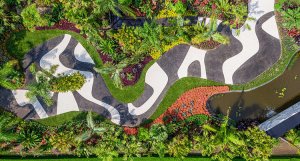
Born in São Paulo in 1909, Burle Marx grew up with a family that instilled a love of art in all six of its children. That also included singing classes, because of his mother’s work as an opera singer. His father was a businessman and gave them all the resources they needed to obtain a rich arts education.
Because of this passion for art, they sent Roberto to Berlin from 1928-1929. He studied art and music there for an entire school year. This trip was absolutely fundamental to his life. He discovered the work of Pablo Picasso, Paul Klee, Wassily Kandinsky, and Vincent Van Gogh.
Going back in time, his family moved to the Leme neighborhood in Rio de Janeiro in 1913. This was also key for him because it was where he began his first plant collection. He was just 7 at the time. His love of plants was later reinforced during visits to the Berlin Botanical Garden during that year-long stay.
After returning from Europe, he enrolled in the Rio de Janeiro School of Fine Arts. But it only took two years for Roberto to become frustrated with their teaching methods.
So, he quit school and began to work on his own projects, with the support of his family. His expressionist period lasted from the late 1920s all the way through to the early 1940s. After that, he began to take an interest in Cubism, which he felt a strong connection to.
He began to work on some of his geometrically unbounded and organically influenced pieces in the 1950s. Something similar happened with colors. He began to use much more lyrical, poetic color schemes.
“A garden is a complex of aesthetic and plastic intentions; and the plant is, to a landscape artist, not only a plant–rare, unusual, ordinary, or doomed to disappearance–but it is also a color, a shape, a volume, or an arabesque in itself.”
-Roberto Burle Marx-
Major works
Copacabana Boardwalk (Rio de Janeiro, Brazil)
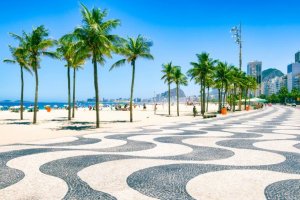
This project began in the 1970s, as a pedestrian walkway to go alongside Avenida Atlántica in Rio de Janeiro. At 4.5 km (2.8 miles) long, it stretches even farther than the Copacabana beach and is as wide as the neighborhood.
This was an urbanization project made to help people enjoy the seaside. What Burle Marx wanted to achieve here was a combination of utility and pleasure for the people who would walk along it.
In other words, he thought that landscape pieces should be more than just objects to look at. They should also have a social function. Burle Marx saw art as a tool not foreign to the average citizen, and as something they should all be able to enjoy in their everyday lives.
A large part of the boardwalk is made of cobbled stones, exclusively for pedestrians. The pavement is made of limestone and has an abstract design, which is a display of Burle Marx’s genius. His use of the black-and-white stone mosaic is a clear reference to Portuguese urban spaces.
He used vegetation in a way that it would provide spaces for people to rest and relax. There are many such areas along the boardwalk. He chose the specific plants with a sculptor’s eye and made sure they could resist the winds coming off from the ocean.
Flamengo Park (Rio de Janeiro, Brazil)
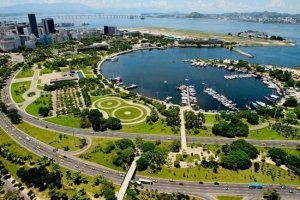
Around 1961, while Carlos Lacerda was in his tenure as Brazil’s president, the construction of Flamengo Park began. The unusual thing about this park is that it’s right alongside the water.
It finally opened in 1965, and ever since then, it’s continued to be one of the most popular parks in all of Rio de Janeiro. It covers 300 acres and was designed by Burle Marx along with the architects Affonso Eduardo Rei and Jorge Moreira.
Flamengo Park has a huge network of bike paths and walking paths that are perfect for long strolls. There are also soccer fields and basketball courts, and even a circular area for model airplane flying. As if that weren’t enough, there’s also a big pond for model boats.
But the real attraction of this park, without any doubt, is the absolute diversity of flora. Burle Marx very carefully picked out the plant species, and most of them are native. That richness of green life also brings a lot of birds to the park.
Parque del Este (Caracas, Venezuela)
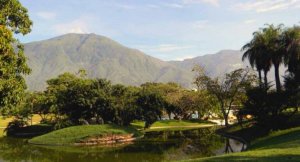
Designed in the late-1950s by Burle Marx, this park is on a former colonial estate around 170 acres wide. The estate was in a very beautiful part of the Caracas Valley, very near to the Carlota Airport.
Burle Marx worked alongside local technicians to transform this space into one of the best works of landscape architecture and contemporary art in the entire city.
Yet again, he incorporated tropical plants but always made sure to use native species. He got his formal inspiration from other modern artists, like Jean Arp. This is what makes the Parque del Este in Caracas an absolute masterpiece of contemporary landscape architecture.
Burle Marx made the use of vibrant native plants in gardens, parks, and boulevards a common practice. These spaces very rarely used plants native to Brazil or any part of Latin America. People generally used foreign plants. It was thanks to him that people began to use native species more frequently in landscape architecture.
Burle Marx also applied some of the art forms he was so brilliant at to his work with landscapes. He always loved the biomorphic shapes of avant-garde sculpture and took inspiration from the work of Miró, Calder, Léger, and other such figures. But his biggest influence was Jean Arp.
So, as you can see, we have a lot to be thankful to Roberto Burle Marx for, when it comes to modern landscape architecture.
Roberto Burle Marx is basically the godfather of modern landscape architecture. He had an absolutely revolutionary way of designing gardens, parks, and other open outdoor spaces.
Experts see this Brazilian designer as one of the most important figures in 20th-century landscape architecture. In the minds of many architects and landscapers, Burle Marx was the creator of the modern garden.
He wasn’t just an architect, either. He was also a brilliant sculptor and worked in other media like painting, wood printing, mosaics, and countless other things. Burle Marx’s childhood was a definitive factor in his professional career as an adult.
It certainly helped to be around and meet masters of Brazilian architecture like Lucio Costa and Oscar Niemeyer. This opened a world of possibilities for him. He collaborated with both of them later on multiple projects. His ideas began to crystallize with a trip to Europe and took clearer shape at the School of Fine Arts in Rio de Janeiro.
His design projects with gardens and other open spaces in Brazil were a total break from the Romantic traditions of 19th century Europe. Burle Marx was able to create his own language in. landscape architecture. He did this by using highly expressive shapes and native plants.
Burle Marx: a life dedicated to art

Born in São Paulo in 1909, Burle Marx grew up with a family that instilled a love of art in all six of its children. That also included singing classes, because of his mother’s work as an opera singer. His father was a businessman and gave them all the resources they needed to obtain a rich arts education.
Because of this passion for art, they sent Roberto to Berlin from 1928-1929. He studied art and music there for an entire school year. This trip was absolutely fundamental to his life. He discovered the work of Pablo Picasso, Paul Klee, Wassily Kandinsky, and Vincent Van Gogh.
Going back in time, his family moved to the Leme neighborhood in Rio de Janeiro in 1913. This was also key for him because it was where he began his first plant collection. He was just 7 at the time. His love of plants was later reinforced during visits to the Berlin Botanical Garden during that year-long stay.
After returning from Europe, he enrolled in the Rio de Janeiro School of Fine Arts. But it only took two years for Roberto to become frustrated with their teaching methods.
So, he quit school and began to work on his own projects, with the support of his family. His expressionist period lasted from the late 1920s all the way through to the early 1940s. After that, he began to take an interest in Cubism, which he felt a strong connection to.
He began to work on some of his geometrically unbounded and organically influenced pieces in the 1950s. Something similar happened with colors. He began to use much more lyrical, poetic color schemes.
“A garden is a complex of aesthetic and plastic intentions; and the plant is, to a landscape artist, not only a plant–rare, unusual, ordinary, or doomed to disappearance–but it is also a color, a shape, a volume, or an arabesque in itself.”
-Roberto Burle Marx-
Major works
Copacabana Boardwalk (Rio de Janeiro, Brazil)

This project began in the 1970s, as a pedestrian walkway to go alongside Avenida Atlántica in Rio de Janeiro. At 4.5 km (2.8 miles) long, it stretches even farther than the Copacabana beach and is as wide as the neighborhood.
This was an urbanization project made to help people enjoy the seaside. What Burle Marx wanted to achieve here was a combination of utility and pleasure for the people who would walk along it.
In other words, he thought that landscape pieces should be more than just objects to look at. They should also have a social function. Burle Marx saw art as a tool not foreign to the average citizen, and as something they should all be able to enjoy in their everyday lives.
A large part of the boardwalk is made of cobbled stones, exclusively for pedestrians. The pavement is made of limestone and has an abstract design, which is a display of Burle Marx’s genius. His use of the black-and-white stone mosaic is a clear reference to Portuguese urban spaces.
He used vegetation in a way that it would provide spaces for people to rest and relax. There are many such areas along the boardwalk. He chose the specific plants with a sculptor’s eye and made sure they could resist the winds coming off from the ocean.
Flamengo Park (Rio de Janeiro, Brazil)

Around 1961, while Carlos Lacerda was in his tenure as Brazil’s president, the construction of Flamengo Park began. The unusual thing about this park is that it’s right alongside the water.
It finally opened in 1965, and ever since then, it’s continued to be one of the most popular parks in all of Rio de Janeiro. It covers 300 acres and was designed by Burle Marx along with the architects Affonso Eduardo Rei and Jorge Moreira.
Flamengo Park has a huge network of bike paths and walking paths that are perfect for long strolls. There are also soccer fields and basketball courts, and even a circular area for model airplane flying. As if that weren’t enough, there’s also a big pond for model boats.
But the real attraction of this park, without any doubt, is the absolute diversity of flora. Burle Marx very carefully picked out the plant species, and most of them are native. That richness of green life also brings a lot of birds to the park.
Parque del Este (Caracas, Venezuela)

Designed in the late-1950s by Burle Marx, this park is on a former colonial estate around 170 acres wide. The estate was in a very beautiful part of the Caracas Valley, very near to the Carlota Airport.
Burle Marx worked alongside local technicians to transform this space into one of the best works of landscape architecture and contemporary art in the entire city.
Yet again, he incorporated tropical plants but always made sure to use native species. He got his formal inspiration from other modern artists, like Jean Arp. This is what makes the Parque del Este in Caracas an absolute masterpiece of contemporary landscape architecture.
Burle Marx made the use of vibrant native plants in gardens, parks, and boulevards a common practice. These spaces very rarely used plants native to Brazil or any part of Latin America. People generally used foreign plants. It was thanks to him that people began to use native species more frequently in landscape architecture.
Burle Marx also applied some of the art forms he was so brilliant at to his work with landscapes. He always loved the biomorphic shapes of avant-garde sculpture and took inspiration from the work of Miró, Calder, Léger, and other such figures. But his biggest influence was Jean Arp.
So, as you can see, we have a lot to be thankful to Roberto Burle Marx for, when it comes to modern landscape architecture.







